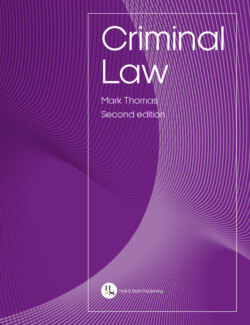Читать книгу Criminal Law - Mark Thomas - Страница 120
Drug-dealing cases
ОглавлениеA specific area of law was required to deal with the circumstance when the defendant supplied drugs to the victim who self-administered such drugs that then resulted in their death or injury.
Following the defendant’s original conduct, where the end result has come about because of the victim’s ‘free, voluntary and informed’ act, the chain of causation will be broken and the defendant is not to be regarded as the legal cause (R v Dalby [1982] 1 All ER 916). Similar to considering the acts of a third party, each element must be satisfied. Where the victim acts in a free and voluntary manner but is uninformed or unaware of the circumstances, they will not break the chain of causation.
The key authority in this area of law is the House of Lords decision in R v Kennedy (No 2) [2008] 1 AC 269.
case example
Charge: Constructive manslaughter
Case progression: Crown Court – Guilty
Court of Appeal – Conviction upheld
Court of Appeal (CCRC reference) – Conviction upheld
House of Lords – Conviction quashed
Point of law: Self-administration by a free, deliberate and informed act will break the chain of causation
In R v Kennedy (No 2) [2008] 1 AC 269, the defendant prepared a syringe of heroin and gave it to the victim upon their request. The victim self-injected and died. The defendant was convicted in the Crown Court for constructive manslaughter (due to the supply of unlawful drugs) and his appeal was dismissed in the Court of Appeal.
The defendant returned to the Court of Appeal a second time (following a Criminal Cases Review Commission (CCRC) reference), where his conviction was again upheld.
The House of Lords allowed his appeal and quashed his conviction, ruling that where the victim acts in a ‘free, voluntary and informed’ manner by self-administering the drug, the chain of causation will be broken and the defendant will not be the legal cause of death despite the supply of the drugs by the defendant.
Lord Bingham concluded:
There is, clearly, a difficult borderline between contributory acts which may properly be regarded as administering a noxious thing and acts which may not. But the crucial question is not whether the defendant facilitated or contributed to administration of the noxious thing, but whether he went further and administered it. What matters … is whether the injection itself was the result of a voluntary and informed decision by the person injecting himself.
Effectively, Lord Bingham ruled that where the victim self-injects, the defendant can never be guilty if the victim is a fully informed adult making a free and voluntary decision. Kennedy (No 2), therefore, had the effect of overruling R v Rogers [2003] 1 WLR 1374 and R v Finlay [2003] EWCA Crim 3868 and reversing the Court of Appeal’s ruling in R v Kennedy (No 2) [2005] EWCA Crim 685. In Rogers, the defendant applied a tourniquet to the victim’s arm, to allow the victim to self-inject. This was held not to break the chain of causation as the defendant was ‘playing a part’ in the mechanics of the injection which caused death. In Finlay, the defendant had produced the situation to allow the victim to inject herself. She did so and died. Both of these cases have now been declared as incorrect in law.
When then will the defendant be liable? As the court in R v Evans [2009] EWCA Crim 650 made clear, ‘supply alone’ is not sufficient for a conviction of unlawful act manslaughter, unless the defendant was under a specific duty to act as a result of creating a dangerous situation (refer back to Miller and Evans above in relation to omissions).
Therefore, post Kennedy (No 2), for liability to be found in these circumstances, the jury would have to be sure that the defendant took part in the administration of the drug.
This means that the defendant must either:
(a) inject the victim himself (R v Cato [1976] 1 All ER 260); or
(b) jointly inject the victim (R v Burgess [2008] EWCA Crim 516).
in practice
Do not forget to consider all the possible outcomes of a case based on similar facts. If the victim dies as a result of injection by the defendant, the defendant may be liable for unlawful act manslaughter. Should the victim live, the defendant may be liable for administering a noxious substance contrary to s 23 of the OAPA 1861. The prosecution will consider all of these outcomes in its case preparation.
For commentary on these cases, see Ormerod and Fortson, ‘Drug Suppliers as Manslaughterers (Again)’ [2005] Crim LR 819 and Jones, ‘Causation, Homicide and the Supply of Drugs’ (2006) 26 LS 139.
